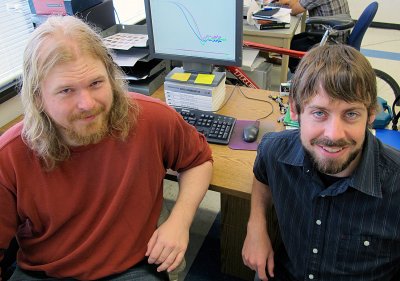EUGENE, Ore. — (Sept. 20, 2012) — University of Oregon scientists have found a way to correctly reproduce not only the structure but also important thermodynamic quantities such as pressure and compressibility of a large, multiscale system at variable levels of molecular coarse-graining. The method is a mathematically driven predictive modeling of a real system, built on liquid state theory, and utilizing powerful computing resources. The team's theory appears in the Oct. 15 issue of the journal Physical Review Letters.
The method is a mathematically driven predictive modeling of a real system, built on liquid state theory, and utilizing powerful computing resources. The team's theory appears in the Oct. 15 issue of the journal Physical Review Letters.
Understanding multiscale systems is of vital importance in biology and material engineering. Because physical properties of multiscale systems develop on an extended range of times and lengths — with changes involving many orders of magnitude — computer simulations at the atomic resolution can exceed even the most advanced computational capabilities.
In recent years theoretical coarse-graining methods have gained attention in the scientific community because they provide an efficient alternative to traditional simulations, which represent explicitly every atom of the molecular system. In course graining, atomistic-level information is removed to make computations at long time- and large length-scales possible. The key issue is how to develop reliable and controllable coarse-graining procedures. Most coarse-graining methods correctly predict the structure of a liquid, but they fall short in predicting thermodynamic properties such as pressure or compressibility.
The new theory has the capability to ensure both structural and thermodynamic consistency, said Marina G. Guenza, professor of theoretical physical chemistry and project leader.
Last year, in the journal Physical Review E, Guenza and doctoral student Ivan Lyubimov, a co-author of the new paper, documented a procedure to reconstruct the realistic dynamics of multiscale systems from the motion measured in dynamic simulations of coarse-grained macromolecules. In this newly published article, the same coarse-graining formalism is shown to reproduce correctly the pressure and compressibility of the system, providing a reliable method to simulate complex macromolecular systems in an extended range of length and timescales.
Thermodynamic properties are important in the mixing of liquid materials used in making plastics, said Anthony J. Clark, a UO doctoral student in physics and lead author of the new paper. "Pressure has been a high-level issue in coarse-graining," he said. "It is important to be able to reproduce the distribution of molecules in a system, and pressure is a hard physical quantity to predict. Our theory now will provide the interaction potentials of coarse-grained molecules, which correctly predict both the structure and the thermodynamics of the sample."
The improvements to the formula for the computational simulation mean that manufacturers soon may be able to use a computer code and input information for the materials they plan to mix and quickly determine the behavior of a finished product, said Guenza, a member of the UO's Institute of Theoretical Science, Materials Science Institute and Institute of Molecular Biology.
A problem in working with polymers, for example, is that they often don't blend easily. Controlling for thermodynamic components is vital.
"These molecules are very complex," said co-author Jay McCarty, a doctoral student in chemistry who derived the equations that prove the thermodynamic consistency of Clark's potential and ran the atomistic simulations the test the theory. "They move at different timescales and cover many lengthscales. Our goal is to bridge phenomena that happen at different scales at the molecular level."
Many manufacturing processes rely on often costly, time-consuming and wasteful trial-and-error procedures. While the scientific program is still under development to be extended to a larger number of systems, Guenza said, the recent developments have addressed major stumbling blocks.
On the horizon, she said, is a web-based computer program at the UO, which manufacturers and researchers will be able to access to run predictive coarse-graining simulations that will facilitate the study of polymeric systems and improve the efficiency of working with these samples.
The National Science Foundation supported the research (grants DMR-0804145 and PHY11-25915).
About the University of Oregon
The University of Oregon is among the 108 institutions chosen from 4,633 U.S. universities for top-tier designation of "Very High Research Activity" in the 2010 Carnegie Classification of Institutions of Higher Education. The UO also is one of two Pacific Northwest members of the Association of American Universities.
Media Contact: Jim Barlow, director of science and research communications, 541-346-3481, jebarlow@uoregon.edu
Source: Marina Guenza, professor, department of chemistry, 541-346-2877, mguenza@uoregon.edu
Follow UO Science on Facebook: http://www.facebook.com/UniversityOfOregonScience
Note: The University of Oregon is equipped with an on-campus television studio with satellite uplink capacity, and a radio studio with an ISDN phone line for broadcast-quality radio interviews. Call the Media Contact above to begin the process.
Media Relations